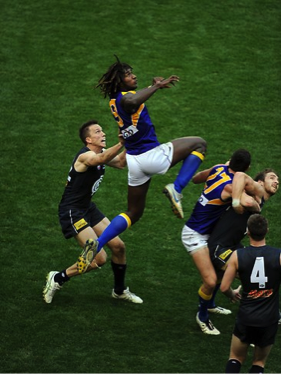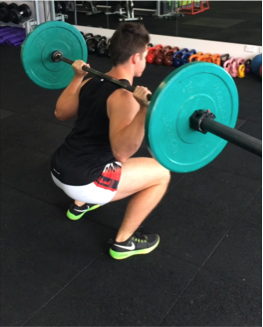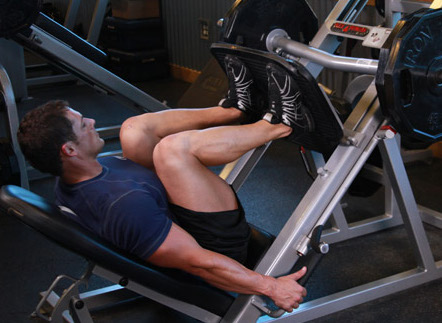Specificity – But how specific is too specific?
If you have read several of the articles on this site, and even more so if you have read any of the books, you will be well versed in the importance of specificity in your training. That is, training specifically for the game of Aussie Rules footy. This would seem fairly obvious, however as would become clear the more you read, there is a little more to this specificity than there initially seems. We have covered much of these principles elsewhere, but I will give a quick review of some key points, and then make a quick point at the end of this article about how to approach this specificity in your training.
Specificity in training can take on several forms;
Metabolic Specificity; This ties in with the energy systems that are being used, and the ratio of the 3 that are contributing to any one time in a game of footy. There are 3 energy systems (ATP-PC, phosphagen and aerobic) of which footy requires a large contribution from each. As a result training should reflect the relative combination of the 3 that are contributing to various tasks in footy. We cover this in detail in Agility, Speed and conditioning for Aussie Rules Footy.
This point also has relevance to the type of strength training you are performing. If you are doing low rep and heavy weight, your training adaption will be geared more to strength gains and less hypertrophy, whereas if you increase the reps and decrease the weight used, the metabolic result will be more muscle gain, but less maximal strength. So what is it you are looking for?
Biomechanical Specificity; Largely concerning movements being trained that are closely related in physical detail to the demands of similar movements performed in a game. For example, you play the game standing, not seated, hence a squat will provide more benefit than a leg press. You jump off 1 leg, so a step up will provide more biomechanical specificity to this particular movement than a squat. In other words, the biomechanical specificity of a training exercise depends not only on the nature of footy in general, but also specifically what it is that you are looking to improve from the exercise (jumping, tackling, pushing an opponent, etc.)



Kinetic & Kinematic Specificity; Don’t worry about the name, what we are talking about here is relative force, speed/velocity and the timing of certain movements. In other words, the closer a training exercise is in terms of the relative force and speed of a particular movement in footy, the more specific that exercise is said to be. For example, a step-up jump or a squat jump is more specific to a jump in footy than a normal step up or a normal squat, as it more closely mimics the speed and rate of force development in a jump in footy. This is a good example of the value of plyometric training. After building strength from functional strength training, plyometric training takes this strength and converts it to usable expressions of footy specific power, by training this speed component. In other words, it uses exercises that have a far more closely related relative force, speed, velocity and timing than the standard strength exercises, and as a result, is more specific to the particular movements in a game of footy.




But don’t approach specificity in the wrong way
Specificity of training isn’t about finding the most specific exercises possible and then performing them to the exclusion of everything else. The more specific exercises that are the most similar to the movements in footy (the plyometric jumps for example) should be combined with the general strength exercises (squat, lunge, single leg deadlift, etc.) This is the case for a few key reasons;
- The general strength exercises such as lunge and squat variations (we keep going back to lower body exercises as these are the easiest to visualise the link between the strength exercises and the more specific plyometric exercises) provide an increased level of base and maximal strength and therefore more potential that can be used in the more specific exercises. Just performing specific exercises on their own will not have anywhere near the same benefit.
- Performing too much specific movement will be more likely lead to overuse injuries and muscle imbalance, especially when combined with the sport itself. In other words, general strength exercises that may not initially seem that specific for footy, such as inverted rows or bent over rows, are needed in order to even out all the pushing that you are doing, especially when taking into account that in a game and club training.
- Having variation throughout your program will also help to avoid plateau’s. Doing too much of the same thing will eventually stop producing a result, even if it involves the most specific exercises available to footy.
Paul Gamble calls this the ‘Paradox of specificity’ in his book Strength & Conditioning for Team Sports. Paul points out the fact that theoretically, the most sport-specific or functional form of training that you can do for a sport is the sport itself. But we also know that in order to improve physically you need an overload that challenges the body to a higher degree than the sport itself will allow (example strength and plyometric training.) The same applies to strength training specifically – yes specific jumping and pushing and rotating exercises that are the most specific to footy are great – they are important – and indeed are in all our books – but they still require a foundation of the less specific exercises to build upon and be combined with as you go along.
This discussion ties in well with a discussion on why leg extension will not make you kick better. Have a look at the discussion on this example here.
Strength Coach

